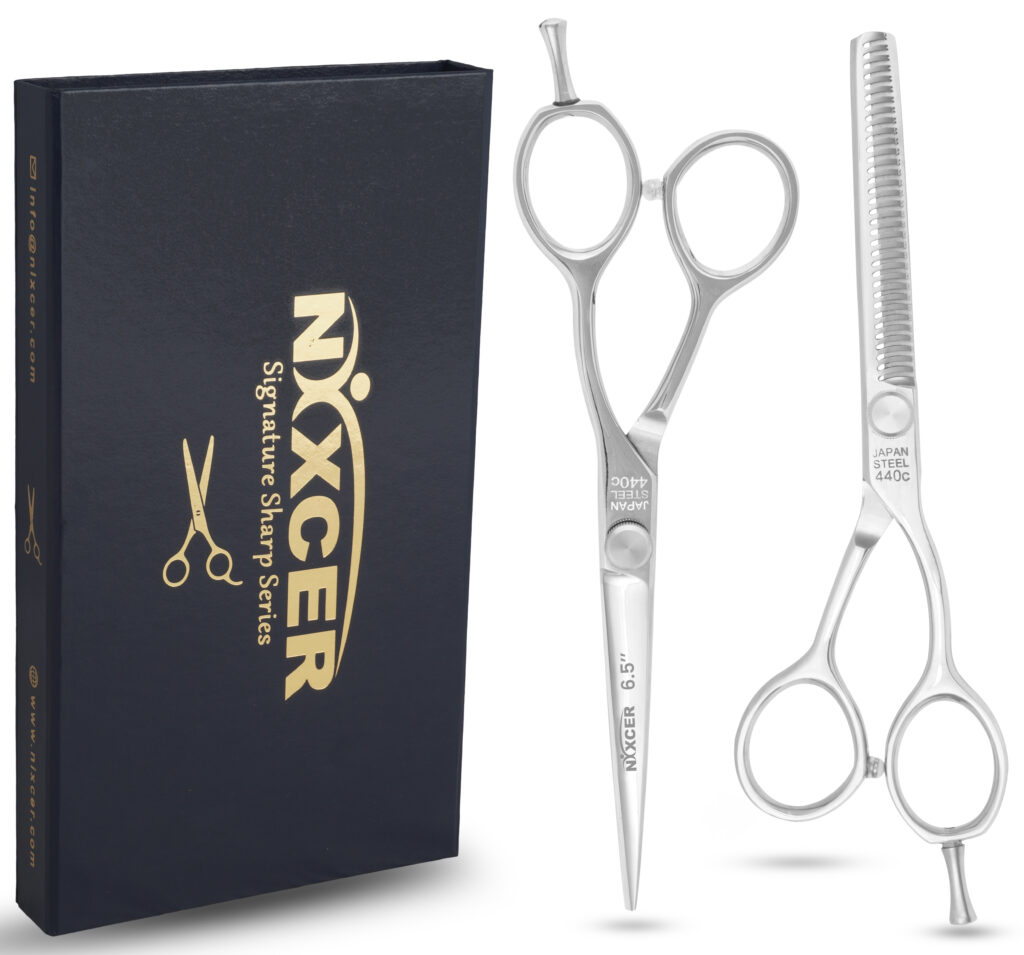Student Scissors vs Professional Hair Cutting Scissors
Student scissors, often used by beginners or those learning the art of hair cutting, differ from professional hair cutting scissors in several key aspects:
1. Quality and Materials
Student Scissors: Typically made from less expensive materials, such as lower-grade stainless steel. They may lack the precision and durability found in higher-end models.
Professional Scissors: Made from high-quality stainless steel or even cobalt or titanium alloys. These materials provide superior sharpness, durability, and resistance to corrosion.
2. Blade Sharpness
Student Scissors: Usually have blades that are not as sharp as professional scissors. This reduces the risk of injury for beginners but may not provide the same clean cut.
Professional Scissors: Feature razor-sharp blades that can make precise cuts, essential for professional-grade styling and detailed work.
3. Ergonomics and Design
Student Scissors: Often have a simpler design with basic ergonomic features. They may not have advanced handle designs that reduce hand fatigue.
Professional Scissors: Designed with ergonomics in mind, including offset handles, finger rests, and swiveling thumb rings to provide maximum comfort and reduce strain during long cutting sessions.
4. Price
Student Scissors: Generally more affordable, making them accessible for those just starting out or those on a budget.
Professional Scissors: Higher in cost due to the quality of materials and craftsmanship. They are considered an investment for professional stylists.
5. Adjustability and Customization
Student Scissors: Typically have fewer options for adjustment and customization.
Professional Scissors: Often come with adjustable tension screws and customizable parts to tailor the scissors to the stylist’s preferences.
6. Maintenance and Longevity
Student Scissors: May require more frequent sharpening and may not last as long as professional scissors with regular use.
Professional Scissors: Designed for long-term use with proper maintenance, including regular sharpening and oiling.
7. Cutting Performance
Student Scissors: Adequate for basic cutting techniques and learning purposes but may struggle with more advanced or precise cuts.
Professional Scissors: Provide exceptional performance for all types of cutting techniques, from blunt cuts to intricate layering and texturizing.
While student scissors are suitable for beginners due to their affordability and safer design, professional hair cutting scissors are essential for experienced stylists who require precision, comfort, and durability in their tools.
Transitioning from student scissors to professional hair cutting scissors is a significant step in a hairstylist’s career. Here’s when and how to make that transition:
When to Transition from Student Scissors to Professional Hair Cutting Scissors
1. Skill Improvement
Once you’ve gained confidence and proficiency in basic cutting techniques, such as blunt cuts, layering, and point cutting, it’s time to consider upgrading.
If you find yourself regularly cutting hair and managing a growing clientele, the improved performance of professional scissors will benefit both you and your clients.
2. Performance Limitations
When you notice that your current student scissors are limiting the quality of your cuts or causing inconsistencies, it’s a sign to upgrade.
If you frequently need to sharpen or repair your student scissors, professional-grade tools may offer better longevity and less frequent maintenance needs.
3. Comfort and Ergonomics
Experiencing hand fatigue or discomfort during extended cutting sessions is a signal that you might benefit from the ergonomic design of professional scissors.
If you’re experiencing any discomfort or strain injuries, the ergonomic advantages of professional scissors can help alleviate these issues.
How to Transition from Student Scissors to Professional Hair Cutting Scissors
1. Research and Education
Familiarize yourself with different brands and types of professional scissors. Look for reviews and seek recommendations from experienced stylists.
Determine the types of cuts you perform most often and choose scissors designed for those techniques.
2. Try Before You Buy
Whenever possible, test different models to find a pair that feels comfortable and suits your cutting style.
Events like trade shows or workshops often allow you to try out different scissors and get advice from industry professionals.
3. Budget and Investment
Professional scissors can be expensive, so set a budget that allows you to invest in a quality pair without overextending yourself financially.
Some retailers offer financing or payment plans for professional tools.
4. Maintenance and Care
Understand how to maintain and care for your new scissors to ensure they last as long as possible. This includes regular cleaning, oiling, and sharpening.
Purchase a good scissor case, oil, and other maintenance tools to keep your scissors in top condition.
5. Gradual Transition
Initially, you can alternate between your student scissors and new professional scissors. This allows you to get accustomed to the new feel and performance gradually.
Use professional scissors for more detailed and precision work, and continue using student scissors for rough cuts or practice on mannequin heads.
Final Thoughts
Transitioning from student to professional hair cutting scissors is a natural progression in your career as a hairstylist. By recognizing the signs that it’s time to upgrade and following a thoughtful process to select and invest in your new tools, you can enhance the quality of your work, improve your comfort, and provide better service to your clients.



